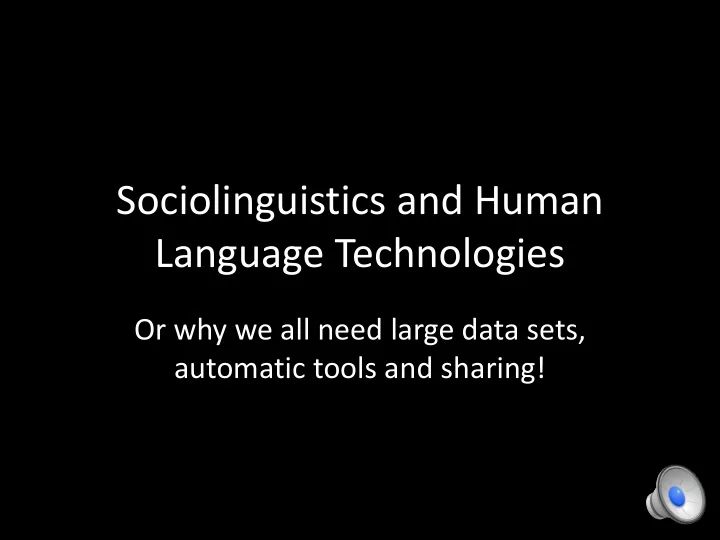

Sociolinguistics and Human Language Technologies Or why we all need large data sets, automatic tools and sharing!
Thesis • LDC and others collect LARGE data sets to drive speech technology research (LID, ASR, DID, etc) • LARGE = – Hundred/Thousands of hours of data per language/dialect – Hundreds/Thousands of speakers – E.g. mixer, fisher, HUB4-5, etc • Many of the technologies that have been developed could support dialect/variation research! – Analysis of large data (word usage, pronunciation, etc.) – Measurement of speaker/dialect variability (intra and inter) – Measurement of channel affects
Case 1 British English vs. American English • WSJ (US English): 200+ hours of read speech • WSJ-CAM0 (British): 90+ hours of read speech • 200+ speakers • Use ASR techniques to learn pronunciation models Literature Proposed System Rule Learned Rule Prob [ae] -> [aa] /_ [+fric, -voiced] [ae] -> [aa] /_ [+fric, -voiced, +front] 0.84 (trap-bath split) [ae] -> [aa] / [-voiced]_ [+fric, -voiced, -front] 0.52 [r] -> ø / _ [+cons] [er] ins -> [ah] / [+vowel] _ [+affric] 1.0 (R Dropping) [er] -> [ah] / l _ [+affric] 1.0 We rediscover known rules AND automatically measured prevalence
Case 2 AAVE/non-AAVE variability • StoryCorps: oral history collect of AAVE/non-AAVE talkers • Simultaneous collection in 15 US cities for NPR • 300+ speakers, 400+ hours / dialect • Automatically identify and retrieve instances of AAVE specific transformations (21 from Wolfram 2005) 0.5 S2: Tri PPM (standard) S3: Tri PPM (sophisticated) A2: Tri APM (standard) 0.4 0.3 0.2 0.1 0 F-measure Precision (recall=0.1)
Mining data for analysis Using the model to explore your corpus Learned rules: uw-[l]: uw-l t iy ch ih z aa r r iy l k uw Sur. t iy ch er z aa r r iy l k uw l Ref. Words: Teachers are real cool
This is just the beginning With more data we will be able to: 1. Characterize in-dialect speaker variability 2. Measure acoustic variability that is too subtle for categorical labeling (see [Shen 09] and [Chen/Shen 11]) 3. Learn rare transformations that are difficult to observe in small data sets. [Chen 10] proposed 700+ AAVE-specific pronunciation transforms 4. Speed data analysis: find regions of dialectal difference using automatic methods
Recommend
More recommend